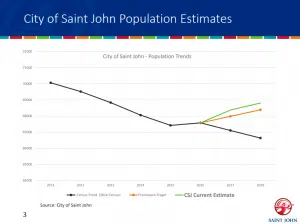
For a number of years, Saint John was the only metropolitan area in the country with a shrinking population.
That’s now changed, according to new data from Statistics Canada.
In it’s demographic estimation report, it says Greater Saint John saw more than 500 people move here,, growing the population to 130,107.
This is the third consecutive year for growth after four steady years of population decline, and decades of bust.
David Dobbelsteyn, manager of population growth for the city of Saint John, gave a presentation to council Monday night further outlining the numbers.
He says that StatsCan doesn’t do demographic estimations for municipalities, so they had to crunch their own numbers from the recent report.
According to their math, the population of the City of Saint John was estimated to be 68,808 in 2018, an increase of 432 people since 2017. That represents an estimated increase of 1233 since the 2016 Census.

Dobbelsteyn says this represents around 500 families, which will bring financial growth to the city.
He says if they follow data trends from other Atlantic provinces, those families will spend about 34 million dollars annually, 12 million of which goes toward income taxes.
“The 1200 new people also has a significant impact on our gas taxes,” he said during a presentation. He estimates the city would get 88 thousand dollars a year for the gas tax revenue.
While other cities in the province have been growing bigger and faster, Dobbelsteyn says this is nothing to compare to, and while Saint John still has a lot more growing to do, it’s finally on the right path.
‘The difference for us is that we were the only shrinking (Canadian Metropolitan Area) in Canada in the last census, so this is a significant rebound. At our lowest point we were losing around .5 per cent a year.”
Dobbelsteyn says in previous years, Saint John was losing 743 people on average to other parts of Canada. This trend is now reversing.

“In the last census, we were seeing on average a 500 people net loss just to Alberta, and now it’s moving in the other direction. There’s over 100 net increase to Saint John just from Alberta alone,” he said.
He says along with new residents coming from other provinces, immigration from other countries is also increasing, with 91 per cent of Saint Jonh’s growth coming through immigration.
The city has also seen an increase in international students, and temporary foreign workers.
“Council has stated that we want to be to most welcoming community in Atlantic Canada. I think it’s important that we see there’s some early low-hanging fruit from this, but that we need to continue on this trend,” he said.
Dobbelsteyn says most immigrants who have moved to Saint John live in Millidgeville, with 25 per cent of it’s population speaking a language other than English or French as their first language.






